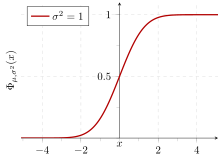Standard deviation

A plot of normal distribution (or bell-shaped curve) where each band has a width of 1 standard deviation – See also: 68–95–99.7 rule
The standard deviation of a random variable, statistical population, data set, or probability distribution is the square root of its variance. It is algebraically simpler, though in practice less robust, than the average absolute deviation.[2][3] A useful property of the standard deviation is that, unlike the variance, it is expressed in the same units as the data. There are also other measures of deviation from the norm, including average absolute deviation, which provide different mathematical properties from standard deviation.[4]
In addition to expressing the variability of a population, the standard deviation is commonly used to measure confidence in statistical conclusions. For example, the margin of error in polling data is determined by calculating the expected standard deviation in the results if the same poll were to be conducted multiple times. This derivation of a standard deviation is often called the "standard error" of the estimate or "standard error of the mean" when referring to a mean. It is computed as the standard deviation of all the means that would be computed from that population if an infinite number of samples were drawn and a mean for each sample were computed. It is very important to note that the standard deviation of a population and the standard error of a statistic derived from that population (such as the mean) are quite different but related (related by the inverse of the square root of the number of observations). The reported margin of error of a poll is computed from the standard error of the mean (or alternatively from the product of the standard deviation of the population and the inverse of the square root of the sample size, which is the same thing) and is typically about twice the standard deviation—the half-width of a 95 percent confidence interval. In science, many researchers report the standard deviation of experimental data, and only effects that fall much farther than two standard deviations away from what would have been expected are considered statistically significant—normal random error or variation in the measurements is in this way distinguished from likely genuine effects or associations. The standard deviation is also important in finance, where the standard deviation on the rate of return on an investment is a measure of the volatility of the investment.
When only a sample of data from a population is available, the term standard deviation of the sample or sample standard deviation can refer to either the above-mentioned quantity as applied to those data or to a modified quantity that is an unbiased estimate of the population standard deviation (the standard deviation of the entire population).
Contents
[hide]Basic examples[edit]
Sample standard deviation of metabolic rate of Northern Fulmars[edit]
Logan [5] gives the following example. Furness and Bryant [6] measured the resting metabolic rate for 8 male and 6 female breeding Northern fulmars. The table shows the Furness data set.| Sex | Metabolic rate | Sex | Metabolic rate |
|---|---|---|---|
| Male | 525.8 | Female | 727.7 |
| Male | 605.7 | Female | 1086.5 |
| Male | 843.3 | Female | 1091.0 |
| Male | 1195.5 | Female | 1361.3 |
| Male | 1945.6 | Female | 1490.5 |
| Male | 2135.6 | Female | 1956.1 |
| Male | 2308.7 | ||
| Male | 2950.0 |

The sample standard deviation of the metabolic rate for the female fulmars is calculated as follows. The formula for the sample standard deviation is
In the sample standard deviation formula, for this example, the numerator is the sum of the squared deviation of each individual animal's metabolic rate from the mean metabolic rate. The table below shows the calculation of this sum of squared deviations for the female fulmars. For females, the sum of squared deviations is 886047.09, as shown in the table.
| Animal | Sex | Metabolic rate | Mean | Difference from mean | Squared difference from mean |
|---|---|---|---|---|---|
| 1 | Female | 727.7 | 1285.5 | -557.8 | 311140.84 |
| 2 | Female | 1086.5 | 1285.5 | -199.0 | 39601.00 |
| 3 | Female | 1091.0 | 1285.5 | -194.5 | 37830.25 |
| 4 | Female | 1361.3 | 1285.5 | 75.8 | 5745.64 |
| 5 | Female | 1490.5 | 1285.5 | 205.0 | 42025.00 |
| 6 | Female | 1956.1 | 1285.5 | 670.6 | 449704.36 |
| Mean = | 1285.5 | Sum of squared differences = | 886047.09 |






No comments:
Post a Comment